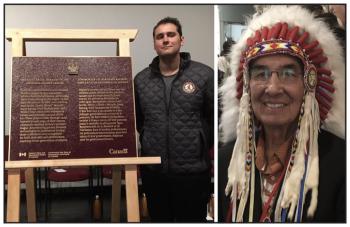Image Caption
Summary
Local Journalism Initiative Reporter
Windspeaker.com
Gabriel Michael and his family members have had their share of tough days the past couple of years.
But Wednesday Dec. 7 was a good day for Michael’s family. The 27-year-old Saskatoon resident is the grandson of Fred Sasakamoose, the Indigenous trailblazer who played 11 games with the Chicago Blackhawks during the 1953-54 season.
Sasakamoose, who was a member of Ahtakakoop Cree Nation in Saskatchewan, died in November of 2020 in hospital from COVID-19 complications.
Michael travelled to Toronto so he could be part of a Historic Sites and Monuments Board of Canada ceremony that was staged at the Hockey Hall of Fame. The ceremony commemorated players that broke racial barriers and inspired greater diversity in professional hockey.
Breaking Racial Barriers in the National Hockey League (NHL) honours the achievements of five hockey players by recognizing the struggles and legacies of Indigenous, Chinese-Canadian, Black, and other racialized players who at different points overcame longstanding prejudice to reach hockey's highest level. Their effort has been designated an event of national historic significance under Parks Canada's National Program of Historical Commemoration.
National historic designations reflect defining moments in the country’s history and are aimed at building a more inclusive society for current and future generations, reads a statement.
Besides Sasakamoose, two other Indigenous players, Paul Jacobs and Elmer Maracle, who was nicknamed Buddy, were also recognized. Willie O’Ree, the first Black player to make it to the NHL and Larry Kwong, the first Asian to accomplish the feat, were also honoured.
“This helps out,” said Michael, who represented his family at Wednesday’s ceremony. “It really helps the family. It’s helping with our grief, for my dad and my grandmother especially. She’s had a tough two years.”
Michael was pleased to be the family rep at Wednesday’s ceremony, even more so since he’s been dealing with health challenges. Earlier this year he was diagnosed with Stage 3 Hodgkin’s lymphoma.
“That’s when my world just flipped upside down,” he said. “I just finished my six months of chemotherapy.”
Gabriel said he will continue to devote plenty of time to preserving his grandfather’s legacy. The Sasakamoose family organizes the Chief Thunderstick National Hockey Championship annually in Saskatoon.
“That’s what we do for our grandfather, to promote and develop Indigenous hockey and his vision,” Michael said. “His vision was to have an Indigenous hockey team at the Olympics.”
As for Maracle, who was born in Ayr, Ont. in 1904 and was a Six Nations member, he played 11 games for the New York Rangers during the 1930-31 season.
A pair of Maracle’s family members – great niece Brenda Baughman and great, great niece Christine Pritchard – said he was enfranchised in order to play in the NHL, losing his Indigenous status.
“They knew he was Indigenous but he couldn’t acknowledge it,” Pritchard said.
Baughman said Maracle would have had his status reinstated but was unclear what year that might have happened.
As for Jacobs, who was a member of Kahnawake Mohawk Territory, there is some confusion on whether he actually played any NHL regular season games.
Jacobs was listed as being on the Toronto Arenas’ opening-day roster for the 1918-19 NHL regular season. But a newspaper report at the time said he would not play for the Arenas and return to the Montreal area instead.
Jacobs was also listed as being in the Arenas’ lineup for a handful of other contests that season but it is not known if he saw any playing time.
Dr. Wilton Littlechild, regarded internationally for his Indigenous rights advocacy, was among those who nominated the five trailblazers to Parks Canada’ historical commemoration program.
“Like many things about Indigenous peoples in Canada and their contributions, they’re hidden stories,” Littlechild said. “This is one story we felt was important to be uncovered, the role of Indigenous hockey players and their contributions to professional hockey despite all the obstacles they had.”
Littlechild said the four-person nomination group he was part of had been lobbying for several years to have their application approved.
“I think all kinds of reasons were given why we couldn’t do it,” he said, adding he felt the designation was long overdue. “But eventually we did a fairly assertive nomination submission that they tried to change to make it softer and we said ‘No. Leave it as we wrote it because the truth has to be told what happened in the early days of the National Hockey League.’”
Adam van Koeverden, a former Olympian who is now parliamentary secretary to the minister of health and to the minister of sport, attended Wednesday’s ceremony, which included a plaque unveiling. That plaque will be permanently housed in the Hockey Hall of Fame.
“Finally, it’s a good feeling to be able to have this day in this space,” Littlechild said. “That in itself will develop more awareness, more capacity and once it gets out more in public, will influence our own players to keep working, to keep trying hard to play professionally, if that’s their dream.”
Local Journalism Initiative Reporters are supported by a financial contribution made by the Government of Canada.

